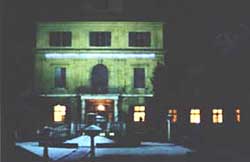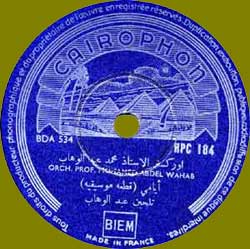TEMPORARY
SOUNDMUSEUM
presents
 Early in 1996 the first Night of lost music took place at the Munich Städtische Galerie im Lenbachhaus while simultaniously the Temporary Soundmuseum was founded by Barbara Holzherr and Kalle Laar. Ever since the Soundmuseum has produced more then 50 events on various themes about music and sound art in general at the Städtische Galerie, about 40 were shown elsewhere. In the beginning none would have thought it possible to sustain this event continuously over what seems now quite a long period of time.
Early in 1996 the first Night of lost music took place at the Munich Städtische Galerie im Lenbachhaus while simultaniously the Temporary Soundmuseum was founded by Barbara Holzherr and Kalle Laar. Ever since the Soundmuseum has produced more then 50 events on various themes about music and sound art in general at the Städtische Galerie, about 40 were shown elsewhere. In the beginning none would have thought it possible to sustain this event continuously over what seems now quite a long period of time.
In 2001 celebrating the five-year anniversary 5 Jahre tkm. rare & obscure the Temporary Soundmuseum issued its first CD.
Samisen-Big-Band-Swing, Winnie The Pooh in Russian, DDR alarm signals, Farfisa Hongkong, Ambient made by Kunst oder Unfall, satellite dreams, Easy Listening from Indonesia, hypnotic fitness and reak hypnosis: it offers a journey through the strange soundworld of the Temporary Soundmuseum.
 Lessons & Instructions
Lessons & Instructions
![]() Gesünder, schlanker, schöner (cd-track 5). Meaning healthier, slimmer, and more beautiful, this record offered exercises for each day of the week. Today: Friday - Feet (ca 1960)
Gesünder, schlanker, schöner (cd-track 5). Meaning healthier, slimmer, and more beautiful, this record offered exercises for each day of the week. Today: Friday - Feet (ca 1960)
![]() The Noise abatement Society (16). A quote from the Talking Newspaper, 3.10.1960: the founding of the Noise Abatement Society in London. This newspaper actually was a language course.
The Noise abatement Society (16). A quote from the Talking Newspaper, 3.10.1960: the founding of the Noise Abatement Society in London. This newspaper actually was a language course.
![]() Cross step (6) &
Cross step (6) &
![]() Side step (19) Balance beam activities for children, including strange dreamy hypnotic music to make them fall off the beam ... (1969)
Side step (19) Balance beam activities for children, including strange dreamy hypnotic music to make them fall off the beam ... (1969)
![]() The C-major Scale (10) or: What happens, if the teacher starts to sing ... (1961)
The C-major Scale (10) or: What happens, if the teacher starts to sing ... (1961)
![]() Signale zur Warnung und Alarmierung (29). Signals of Warning and Alarm. What to do, if the bomb falls on the now gone DDR (1960s)
Signale zur Warnung und Alarmierung (29). Signals of Warning and Alarm. What to do, if the bomb falls on the now gone DDR (1960s)
![]() Klang & Rhythmus (31) Sound & Rhythm. From the series What is Music?
Klang & Rhythmus (31) Sound & Rhythm. From the series What is Music?

Healing
![]() Auskultationsbefunde des Herzens (14). Sounding the rhythms of the (not so sound) heart with Dr. med Wolter (ca 1960)
Auskultationsbefunde des Herzens (14). Sounding the rhythms of the (not so sound) heart with Dr. med Wolter (ca 1960)
![]() Ruhehypnose (20) Hypnosis for Calming down with Dr. med Karl Marx. A one of a kind aural document from the Dr. Frankenstein among the Hypnotists (1960s) (also look under tkm-favorites)
Ruhehypnose (20) Hypnosis for Calming down with Dr. med Karl Marx. A one of a kind aural document from the Dr. Frankenstein among the Hypnotists (1960s) (also look under tkm-favorites)
![]() Heilende Rhythmen: Healing Rhythms. Evocations in Boralesgamuwa, Ceylon (22). File under: Pharmacy ads. A sounding postcard give-away for doctors. From the series Healing Songs of Primitive People from around the World, part 3 (ca 1958)
Heilende Rhythmen: Healing Rhythms. Evocations in Boralesgamuwa, Ceylon (22). File under: Pharmacy ads. A sounding postcard give-away for doctors. From the series Healing Songs of Primitive People from around the World, part 3 (ca 1958)

![]() Gene Tunney(11). Exercises with the 1926-28 boxing world champion, the "Ur-fitness record" (ca 1927)
Gene Tunney(11). Exercises with the 1926-28 boxing world champion, the "Ur-fitness record" (ca 1927)
Stereo
![]() Guida nel suono a 3 dimensioni (3).
Guida nel suono a 3 dimensioni (3).
Gentili ascoltatori... A foray into 1960s stereo madness, italian style (1960s)
Insects
![]() Der Gesang der heimischen Heuschrecken (25) The singing of native crickets. Issued by the agricultural ministery of Niedersachsen, Germany, very quiet & beautiful (ca 1980) (look also under tkm-favorites)
Der Gesang der heimischen Heuschrecken (25) The singing of native crickets. Issued by the agricultural ministery of Niedersachsen, Germany, very quiet & beautiful (ca 1980) (look also under tkm-favorites)
Hybrid: tradition meets western instruments
![]() Professor Mohamad Abdel Wahab (9) Mr. Wahab is best known for his worrk as the director of the orchestra that accompanied the legendary Om Kalsoum.
Professor Mohamad Abdel Wahab (9) Mr. Wahab is best known for his worrk as the director of the orchestra that accompanied the legendary Om Kalsoum.
In his homeland Egypt though he is regarded as one of the most influential musicians in classical as well as more popular music.
![]() Sevil: Mugam (13) The group from Azerbaijan Sevil combines Jazz with elements of traditional arabic music (ca 1974)
Sevil: Mugam (13) The group from Azerbaijan Sevil combines Jazz with elements of traditional arabic music (ca 1974)
Advertisement
![]() from the depths of the vinyl ad vaults,
from the depths of the vinyl ad vaults,
today: Welcome to the pizza parlour (28)
You lighten up my life makes you dream away. Be careful not to sink in your pizza ...
Kunst oder Unfall
![]() Prime Cut (15) &
Prime Cut (15) &
![]() Day to Day (30)
Day to Day (30)
Live Ultraschall Munich (2001)
Film
Movie Ad/Intro (1): We don't tell you the title (clickon the cd-cover above)
![]() Vinni Puch’s song, Evgeny Leonov, voc. The russian version of Winnie the Pooh (7) by legendary animation filmmaker Fedor Chitruk was very popular in the 1970s in the former USSR. Even the Disney-masters thought it to be the best version ever.
Vinni Puch’s song, Evgeny Leonov, voc. The russian version of Winnie the Pooh (7) by legendary animation filmmaker Fedor Chitruk was very popular in the 1970s in the former USSR. Even the Disney-masters thought it to be the best version ever.
 Great Voices
Great Voices
![]() Romica Puceanu (18): Nu ma amagi, baiete (Don’t sweeten me up, boy) One of the greatest singers of (not only) Rumania. The music is a mixture of turkish and rumanian elements spiced up with music gypsy music. Around 1970 Romica was the queen of thes genre (look also under tkm-favorites)
Romica Puceanu (18): Nu ma amagi, baiete (Don’t sweeten me up, boy) One of the greatest singers of (not only) Rumania. The music is a mixture of turkish and rumanian elements spiced up with music gypsy music. Around 1970 Romica was the queen of thes genre (look also under tkm-favorites)
![]() Kuangaly Shumaliev: Great Ayday (26)
Kuangaly Shumaliev: Great Ayday (26)
Found in the local departement store version of Kustanai, Kazachstan, back in 1988. We buy copies of all the few records available. Among them the amazing singing physicist Shumaliev,
immedeately unforgettable (1988)
 Djakarta Lounge
Djakarta Lounge
![]() Ma Jianuo (or Xina): Small Street (4) & When I'm there you don't have to be afraid (17) Farfisa-
Ma Jianuo (or Xina): Small Street (4) & When I'm there you don't have to be afraid (17) Farfisa-![]() like groove from Hongkong by Miss Xina, sounds like live from the Hilton Hotel lounge ...
like groove from Hongkong by Miss Xina, sounds like live from the Hilton Hotel lounge ...
![]() Orkes Gumarang: Oi Kampuang (8)
Orkes Gumarang: Oi Kampuang (8)
Smooth & swing-top easy-listening from Indonesien, ca 1964
![]() Lucky Trio: The scent of the night (21) Taiwanese barbershop singing (by the Globus Musikgroup for Light Music). Groovy, sleek, perfect (ca 1952)
Lucky Trio: The scent of the night (21) Taiwanese barbershop singing (by the Globus Musikgroup for Light Music). Groovy, sleek, perfect (ca 1952)
(look also under tkm-favorites)
![]() Gapura: Baramaen (24) Degung-style Indonesia, meaning a blend of traditional instruments with popular melodies, 'Gamelan with a pop-feel' (1970er)
Gapura: Baramaen (24) Degung-style Indonesia, meaning a blend of traditional instruments with popular melodies, 'Gamelan with a pop-feel' (1970er)
![]() Julia: Di Singapura (32) Again best-quality easy-listening, this time from Malaysia (late 1950s)
Julia: Di Singapura (32) Again best-quality easy-listening, this time from Malaysia (late 1950s)

Japan
![]() Mihashi: The Feast of the people from Tsugaru (2). Intriguing encounter of traditional Samisen (three-stringed japanische banjo) and swinging bigband-sound (1960s)
Mihashi: The Feast of the people from Tsugaru (2). Intriguing encounter of traditional Samisen (three-stringed japanische banjo) and swinging bigband-sound (1960s)
![]() Matsuo Kazuko: Goodnight sweetheart, goodnight (33) Breathy classical Big-City-bar-music meets Enka, the traditional japanese popmusic (1968)
Matsuo Kazuko: Goodnight sweetheart, goodnight (33) Breathy classical Big-City-bar-music meets Enka, the traditional japanese popmusic (1968)

John Cage
![]() John Cage: Amores. Maro Ajemian, prepared piano (23)
John Cage: Amores. Maro Ajemian, prepared piano (23)
One of if not the earliest recording of a piece for prepared piano played by one of the first and most important interpreters. Because of the very bad sound quality due to the rather miserable state of this extremely rare 78, we offer an excerpt only (1947)
From the collection of the late fluxus artist Dick Higgins, partly acquired by the Temporary Soundmuseum.
Temporary Soundmuseum presents ... 15.- euros plus shipping. Order here



